
The Wii is a home video game console developed and marketed by Nintendo. It was released on November 19, 2006 in North America, and in December 2006 for most other regions of the world. It is Nintendo's fifth major home game console, following the GameCube and is a seventh-generation console alongside Microsoft's Xbox 360 and Sony's PlayStation 3.

A pedometer, or step-counter, is a device, usually portable and electronic or electromechanical, that counts each step a person takes by detecting the motion of the person's hands or hips. Because the distance of each person's step varies, an informal calibration, performed by the user, is required if presentation of the distance covered in a unit of length is desired, though there are now pedometers that use electronics and software to determine how a person's step varies automatically. Distance traveled can be measured directly by a GPS receiver.
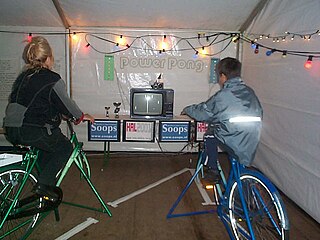
Fitness game, exergame, and gamercise are terms used for video games that are also a form of exercise. Fitness games rely on technology that tracks body movement or reaction. The genre has been used to challenge the stereotype of gaming as a sedentary activity, and promoting an active lifestyle among gamers. Fitness games are seen as evolving from technology aimed at making exercise more fun.

The Wii Balance Board is an accessory for the Wii and Wii U video game consoles. Unlike the usual balance board for exercise, it does not rock but instead tracks the user's center of balance. Along with Wii Fit, it was introduced on July 11, 2007, at the Electronic Entertainment Expo.

Wii Fit is a 2007 exergaming video game designed by Nintendo's Hiroshi Matsunaga for the Wii home video game console, featuring a variety of yoga, strength training, aerobics, and balance mini-games for use with the Wii Balance Board peripheral. Matsunaga described the game as a "way to help get families exercising together". It has since been adopted by various health clubs around the world, and has previously been used for physiotherapy rehabilitation in children and in nursing homes to improve posture in the elderly.
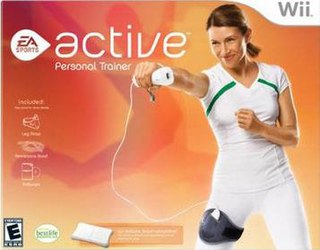
EA Sports Active: Personal Trainer is a video game developed by EA Canada for the Wii console. It was released on May 19, 2009 in North America. The game ships with a strappable pouch to hold the Nunchuk and a resistance band.

Wii is a series of simulation games published by Nintendo for the game console of the same name, as well as its successor, the Wii U. After a seven-year hiatus, the game Nintendo Switch Sports, described officially as "a new iteration of the Wii Sports series," was announced, the first game to drop the "Wii" from its title. These games feature a common design theme, with recurring elements including casual-oriented gameplay, casts consisting mostly or entirely of Miis, and control schemes that simulate real-life activities.
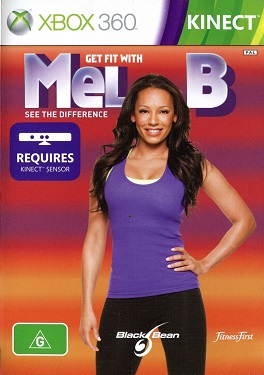
Get Fit with Mel B is a fitness video game developed by Lightning Fish and released for all three major seventh-generation consoles: the PlayStation 3, Wii and Xbox 360, utilizing each console's advanced motion control accessory for fitness gameplay.
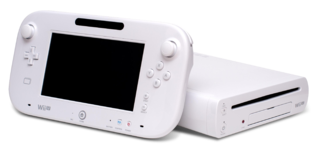
The Wii U is a home video game console developed by Nintendo as the successor to the Wii. Released in late 2012, it is the first eighth-generation video game console and competed with Microsoft's Xbox One and Sony's PlayStation 4.
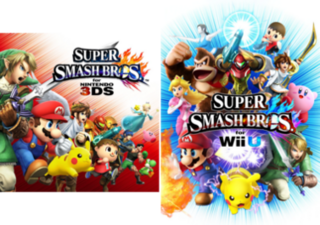
Super Smash Bros. for Nintendo 3DS and Super Smash Bros. for Wii U, both commonly referred together as Super Smash Bros. 4, are 2014 crossover platform fighter video games developed by Bandai Namco Studios and Sora Ltd. and published by Nintendo for the Nintendo 3DS and Wii U video game consoles. It is the fourth installment in the Super Smash Bros. series, succeeding Super Smash Bros. Brawl. The Nintendo 3DS version was released in Japan on September 13, 2014, and in North America, Europe, and Australia the following month. The Wii U version was released in North America, Europe, and Australia in November 2014 and in Japan the following month.

The Wii U GamePad is the standard game controller for Nintendo's Wii U home video game console. Incorporating features from tablet computers, the GamePad has traditional input methods, touchscreen controls, and motion controls. The touchscreen can be used to supplement a game by providing alternate, second screen functionality or an asymmetric view of a scenario in a game. The screen can also be used to play a game strictly on the GamePad screen without the use of a television display. Conversely, non-gaming functions can be assigned to it as well, such as using it as a television remote.
The Nintendo Network was an online service run by Nintendo which provided free online functionality for the Nintendo 3DS and Wii U systems and their compatible games. Announced on January 26, 2012, at an investors' conference, it was Nintendo's second online service after Nintendo Wi-Fi Connection. Former president of Nintendo Satoru Iwata said, "Unlike Nintendo Wi-Fi Connection, which has been focused upon specific functionalities and concepts, we are aiming to establish a platform where various services available through the network for our consumers shall be connected via Nintendo Network service so that the company can make comprehensive proposals to consumers."

Nintendo Land is a party video game developed and published by Nintendo as a pack-in launch title for the Wii U home video game console in 2012. The game was first announced at E3 2012 during Nintendo's press conference.

The Wii U operating system is the official firmware version and system software for the Nintendo's Wii U home video game console. Nintendo maintains the Wii U's systemwide features and applications by offering system software updates via the Internet. Updates are optional to each console owner, but may be required in order to retain interoperability with Nintendo's online services. Each update is cumulative, including all changes from previous updates.

Off-TV Play is a feature of Nintendo's eighth-generation video game console, the Wii U. Like all video game consoles, the Wii U uses a console and a controller to manipulate an image on a television screen. The Wii U's unique feature is that its controller, the Wii U GamePad, has its own built-in screen for displaying images. It can display an entirely different image, or duplicate the television screen into the Wii U GamePad. Off-TV Play is the term used for when an entire game is played strictly on the controller, without the use of a television. The GamePad also features two speakers that can be used for Off-TV Play. There is no standardized way to activate Off-TV Play and how it's implemented depends on the game.
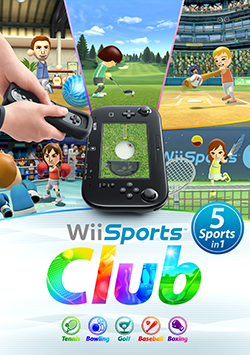
Wii Sports Club is a sports simulation video game, developed by Nintendo and Bandai Namco Studios and published by Nintendo for the Wii U throughout 2013 and 2014. It is the third entry in the Wii Sports series, a part of the larger Wii series. As an enhanced remake of the 2006 Wii launch title Wii Sports, it includes five minigames that replicate Tennis, Baseball, Bowling, Golf, and Boxing, and are controlled with motion controls that replicate the sports. New to the game is additional control schemes using the Wii U GamePad, online multiplayer, and Wii Motion Plus support. Players are organized into clubs that represent different regions, and scores and stats are tracked on Nintendo's social network Miiverse. Players could also communicate with each other during and after online matches using Miiverse. Each sport can be purchased individually or rented for a certain amount of time via a pass.

Fitness Boxing is a fitness video game developed by Imagineer for the Nintendo Switch. The game was released on December 20, 2018 in Japan by Imagineer, December 21, 2018 in PAL territories and January 4, 2019 in North America by Nintendo.

Ring Fit Adventure is an exercising action role-playing game developed and published by Nintendo for the Nintendo Switch. The game comes with two physical components: the Ring-Con, a Pilates ring that the user holds and one Joy-Con slots into, and a Leg Strap, a piece of fabric affixed to the user's leg that holds the other Joy-Con.
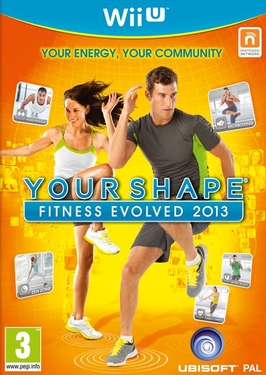
Your Shape: Fitness Evolved 2013 is a fitness video game developed by Blue Byte and published by Ubisoft. The game was released on November 18, 2012, in North America, and on November 30, 2012, in Australia and Europe for the Wii U. The game is the sequel to Your Shape: Fitness Evolved 2012 for the Xbox 360.



















